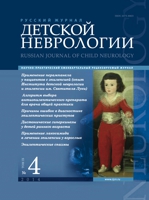Vol 9, No 4 (2014)
- Year: 2014
- Published: 15.12.2014
- Articles: 9
- URL: https://rjdn.abvpress.ru/jour/issue/view/4
Full Issue
AUTHENTIC ARTICLES
ELECTROENCEPHALOGRAPHIC CHANGES WITH DRAVET SYNDROME
Abstract
Dravet syndrome (DS, severe myoclonic epilepsy of early infancy) is epileptic encephalopathy with onset in the first year of life, manifested with febrile and afebrile generalized and focal seizures, with the presence of myoclonic paroxysms in typical cases, mental retardation, and resistance to antiepileptic therapy. The disease was for the first time described by Ch. Dravet in 1978 in France, then, in details, by Сh. Dravet et al. in 1982. In the classification of 1989, DS held a particular place being attributed to the forms of epilepsy that have both generalized and focal clinical manifestations. According to Proposed diagnostic scheme for people with epileptic seizures and with epilepsy (2001), this disease is attributed to epileptic encephalopathies of early infancy. The main reason of DS development is a mutation in the SCN1A gene revealed with most (but not all) patients. It is assumed that there are certain other mutations that determine DS development, in particular, the GABRG2 mutation. Polymorphism of epileptic seizures is typical of the DS: febrile seizures, focal motor (including hemiclonic and secondarily generalized), generalized tonic and clonic, alternating hemiconvulsions, myoclonic, atypical absences, focal dialeptic seizures, as well as epileptic status. The prognosis of the disease is severe. In most cases, seizures continue to occur in adult life but with lower frequency than in childhood. The authors review the issues of etiology and pathogenesis in details, as well as clinical manifestations, diagnostics, and treatment of the DS. A particular emphasis is given to pathological changes on electroencephalogram (EEG) of patients with DS. Distinct slowing of background activity, prevalence of multiregional epileptiform activity, regional slowing, and severe photosensitivity (pattern sensitivity) are the most prognostically unfavorable EEG patterns of the DS.
 6-13
6-13


PERAMPANEL (FYCOMPA) FOR TREATMENT OF EPILEPSY (EXPERIENCE OF THE SVT. LUKA'S INSTITUTE OF CHILD NEUROLOGY AND EPILEPSY)
Abstract
 14-19
14-19


EPILEPTIC SPASMS
Abstract
Epileptic spasms are epileptic seizures with sudden flexion/extension or of the mixed flexion and extension type, mainly involving the proximal and truncal muscles, that are normally longer than myoclonic seizures but shorter than tonic seizures, and last for about 1 second. For diagnostics of epileptic spasms, it is necessary that they are combined with ictal and interictal epileptiform patterns on electroencephalography (EEG). The first detailed clinical description of seizures of the infantile spasms type was provided by English pediatrician W.J. West in 1841. The term of infantile spasms is limited with age and means epileptic spasms that occur to children in early infancy, usually up to 1 y.o. Infantile spasms cannot be synonymous to the West syndrome. Infantile spasms are a type of epileptic seizures and West syndrome is a form of epilepsy that is usually manifested through hypsarrhythmia on the EEG and mental retardation, apart from infantile spasms. Epileptic spasms is the term broader than infantile spasms. Committee of the International League Against Epilepsy (ILAE) recommends exactly the “epileptic spasms” term, as this type of seizures is not a prerogative of the West syndrome and can be observed in children older than 1 y.o. and even in adults. The authors provided a detailed review of modern references devoted to epileptic spasms including the history of the issue, determination of the term, and position of epileptic spasms in modern classification systems, approaches to diagnostics including differential diagnosis, treatment, and prognosis.
 20-29
20-29


MAJOR PRINCIPLES OF EPILEPSY TREATMENT. ALGORITHM OF SELECTION OF ANTIEPILEPTIC DRUGS
Abstract
The authors reviewed general principles of epilepsy treatment in details as well as provided their proprietary algorithm of selection of antiepileptic drugs developed Svt. Luka's Institute of Child Neurology and Epilepsy. This algorithm is designed for general practitioners that deal with treatment of epilepsy. In the course of selection of the first antiepileptic drug, the doctor must take into consideration the age of the patient, assess their level of development, clinical manifestations of seizures, data of electroencephalography and magnetic resonance imaging. The data received allows determination of the type of seizures, supposing of the syndrome-related diagnosis, and selection of the most appropriate antiepileptic drug of first choice in each specific case. There are also recommendations for further examination of patients and monitoring of efficacy of therapy.
 30-39
30-39


ANALYSIS OF MAIN REASONS FOR MISTAKES IN DIAGNOSTICS OF EPILEPTIC SEIZURES AND EPILEPTIC SYNDROMES (CLINICAL PECULIARITIES OF EPILEPTIC SEIZURES)
Abstract
 40-48
40-48


REVIEWS AND LECTURES
DYSTONIA IN CHILDREN (A LECTURE)
Abstract
Distonia is a movement disorder associated with imbalance of excitatory neurotransmitters, and it is characterized by continuous or episodic muscle contraction that forms repetitive stereotyped movements and/or postures. Dystonic hyperkinesia of younger children can be included into the structure of many syndromes that have different etiological factors, prognosis, and treatment. Different clinical variant of dystonia are represented: idiopathic benign dystonia with the onset in the first year of life; dystonia against the background of residual damage to the nervous system; hereditary idiopathic and symptomatic dystonia with various syndromes and metabolic diseases; similar conditions. Diagnostics of dystonia of children requires application of a wide range of examinations, including neuroimaging, continuous video electroencephalographic monitoring, genetic research. Differential diagnosis of dystonia of children is performed regarding various paroxysmal states of childhood of the epileptic and non-epileptic nature.
 49-58
49-58


EFFICACY AND TOLERABILITY OF LACOSAMIDE (VIMPAT) FOR TREATMENT OF EPILEPSY IN ADULTS (A REVIEW)
Abstract
 59-68
59-68


NEUROLOGY NEWS
 69
69


ADVANCED TRAINING
 70
70











